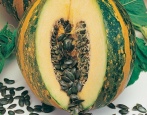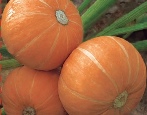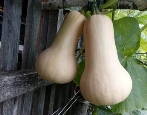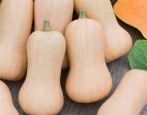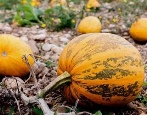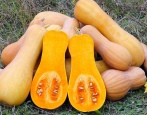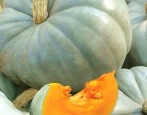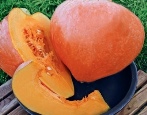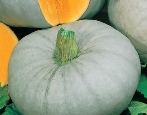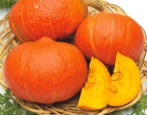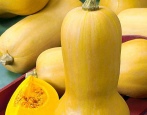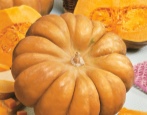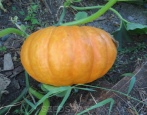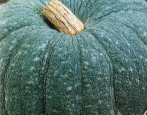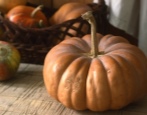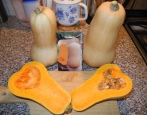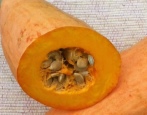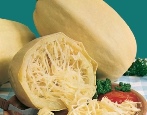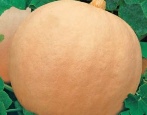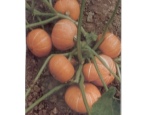
- Authors: Italy
- Name synonyms: Marina di Chioggia
- Growth type: powerful
- The form: round, flat, sometimes in the form of a large turban
- Weight, kg: 10-12
- Coloration: from gray to blue-green to green
- Bark: wrinkled
- Color of the pulp: yellow-orange
- Pulp (consistency): tender, dry, thick
- Taste: sweet
Italian pumpkin varieties are distinguished by their extraordinary taste and high yield. Pumpkin Marina from Chioggia has not only excellent taste, but also an unusual appearance. In its homeland, it has unprecedented popularity, and now it is beginning to be actively cultivated in some regions of Russia.
Description of the variety
The Italian variety has a universal purpose, as well as a number of advantages for which the culture is so much loved.
The first thing that catches your eye when growing a pumpkin is its unique and unusual appearance. This variety cannot be confused with any other due to the shape and structure of the peel.
The pulp contains a high amount of sugar, which makes the culture very tasty and rich in flavor.
Summer residents note that the pumpkin does not have any third-party odors (for example, marsh).
Pumpkin Marina from Chioggia is suitable for storage in a cellar or pits.
Among the disadvantages, it can be noted that the variety has a long ripening period, therefore, for some regions, the pumpkin is not suitable for growing.
Due to its unusual shape, the vegetable is quite difficult to peel. And it is also noted that because of this, the land is hard to clean. That is why it is almost impossible to cook pumpkin without peeling it.
Characteristics of the appearance of plants and fruits
The bush is strong and very climbing. A sufficient number of buds are formed, but due to the fact that the fruits ripen in large sizes, it is recommended to thin out the peduncles.
The fruits are round in shape, flattened on both sides, sometimes they are formed in the form of a turban. By weight, one vegetable can weigh from 10 to 12 kg.
As soon as the pumpkin begins to form, it has a regular rounded shape, and its skin is smooth. When it begins to actively ripen, deep grooves, ribs and warts will begin to appear on the bark, and it will also become wrinkled. The ripe vegetable is gray to blue-green in color.
The pulp is thick, dense, tender and dryish, yellow-orange in color. Inside, an average-sized seed nest is formed. Small seeds are placed in the chamber in an amount of no more than 25 pieces.
Pumpkins are stored in a dry place for more than a year.
Purpose and taste
The pumpkin pulp of the Marina from Chioggia has a rather sweet taste, which gives off tropical fruits. The fruit has a rather strong honey aroma.
The culture is universal, so it is suitable for home cooking. Pumpkin can be used to make vegetable stews, purees, juices, preserves, and can also be used for desserts.
Since the fruits are stored for a year, the pulp is usually not frozen.
Ripening terms
Pumpkin belongs to mid-late crops. Technical maturity occurs after 90 days. But full ripeness after 120-130 days.
Harvesting occurs in August-September.
Yield
It is recommended to leave no more than 1-2 buds on one plant, since they can weigh up to 10 kg. Therefore, the yield from one bush is from 20 kg.
Growing and care
For warmer regions, you can plant seeds in open ground immediately. For cool climates, it is better to choose the seedling method.
If September is very warm every year, then you can sow seeds at the end of May. If not, then sow in peat pots in April.
Seeds should be pretreated. They are soaked in hot water for a day, then germinated, and then quenched in the refrigerator. In between, the material can be treated with a solution of potassium permanganate.
Nutrient soil should include peat, manure or humus, mullein, and turf. This mixture should be thoroughly mixed and placed in peat pots 5 to 8 cm in size.
1-2 seeds are laid to a depth of 2-3 cm, covered with earth and spilled with warm water. In order for the seedlings to appear faster, the containers can be covered with foil.
All seedlings are grown at room temperature.
The seedlings are ready for transplanting when they have 2 to 4 strong leaves.
The bed is formed in advance. The pumpkin grows very well on an old compost pit or on a dung heap. From this environment, the culture receives all the necessary nutrients and minerals. The holes are formed according to the scheme 100x100 cm. Their depth should be the height of the peat pot plus the distance to the cotyledons.
If pumpkins are grown on compost or manure, then saturated watering is necessary, since such soil takes up a lot of moisture. If the culture grows in the garden bed, then irrigation is infrequent, but very abundant.
You can feed it every 14 days with a mullein solution.
You should actively loosen the soil until the bush forms 5 full leaves. This will help the root system develop deeper.
And also some summer residents recommend manually pollinating flowers. It is necessary to pick the male flowers, remove the petals from them and run them several times over the female buds.
Disease and pest resistance
Pumpkin Marina from Chioggia has good immunity, but sometimes it is attacked by some diseases and pests:
powdery mildew;
bacteriosis;
root rot;
spider mite;
slugs;
melon aphid.
